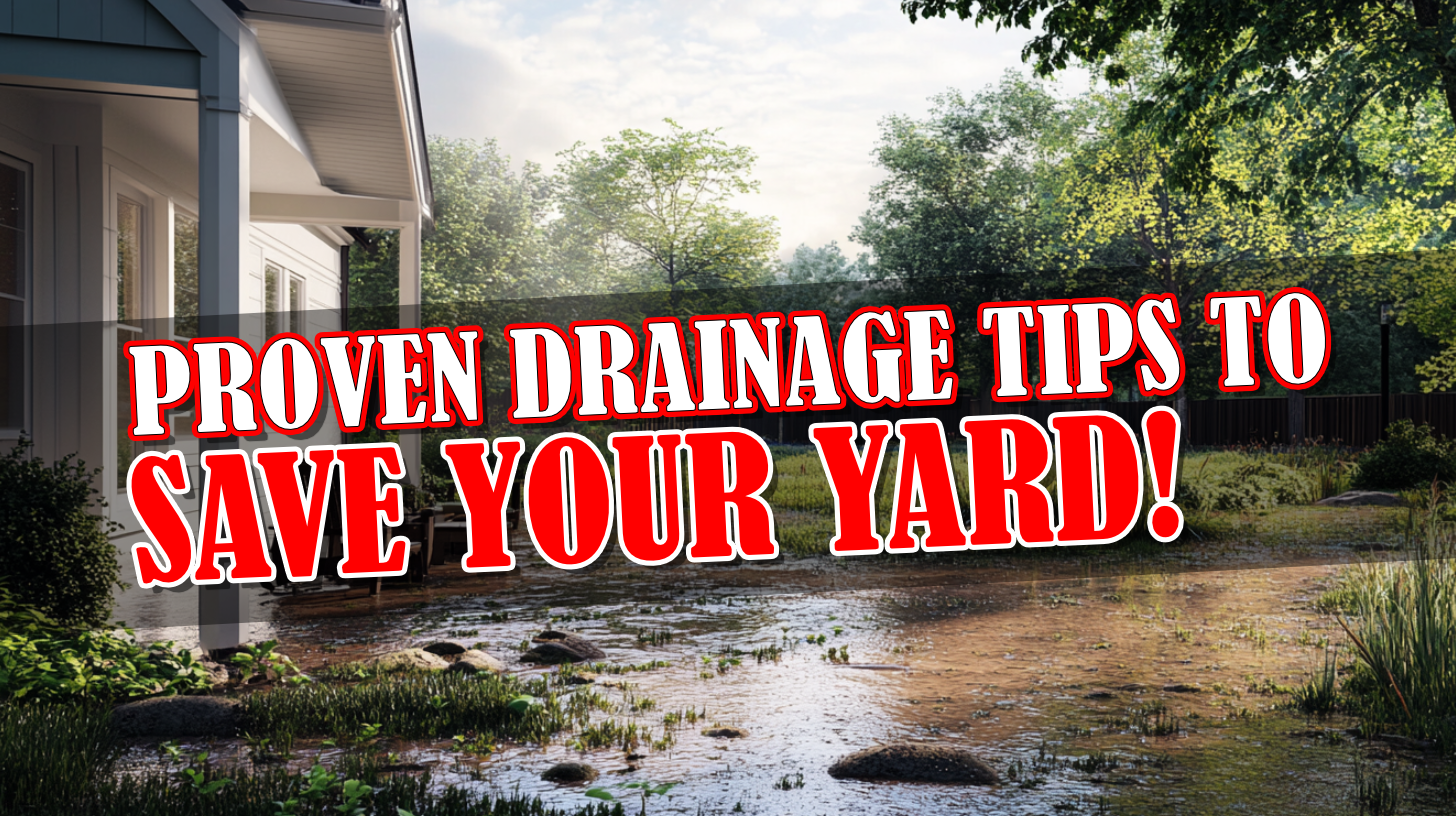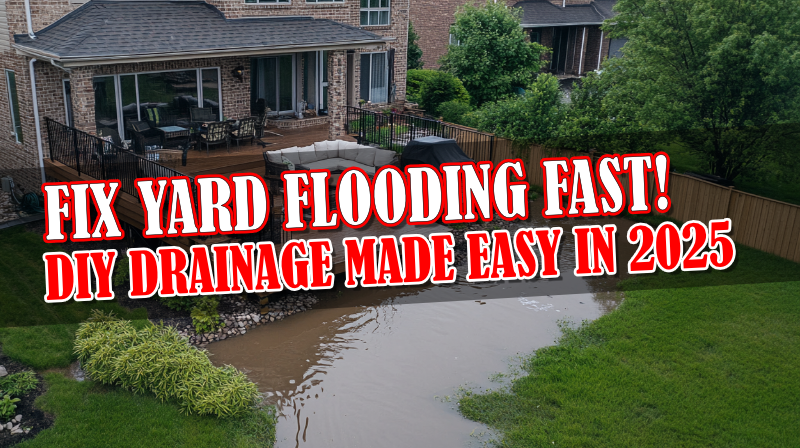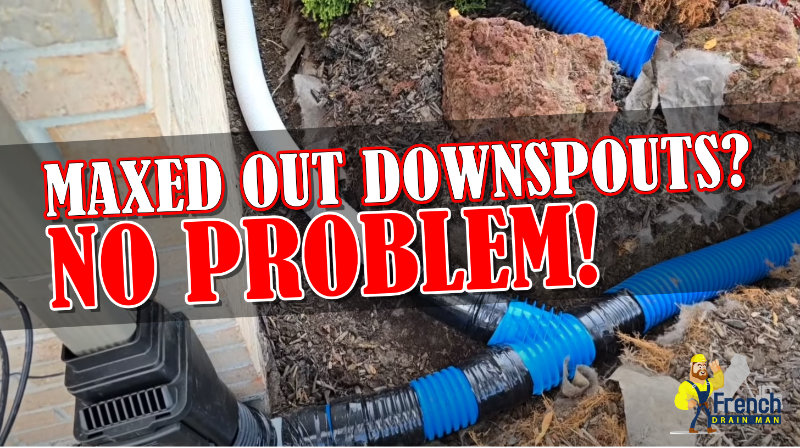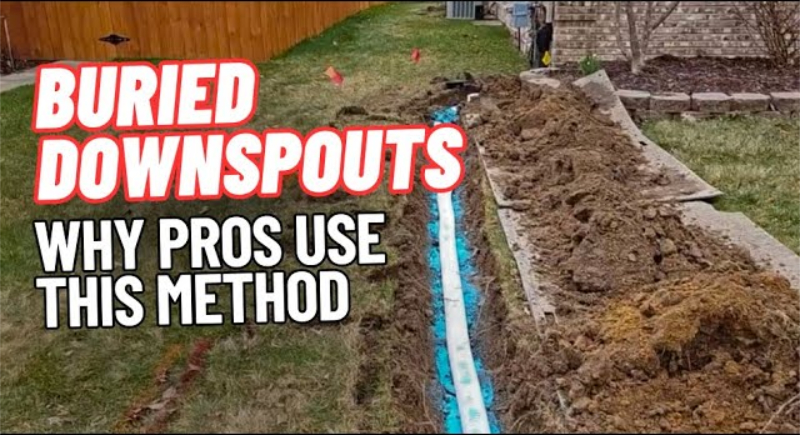Two Residential Underground Downspout Systems
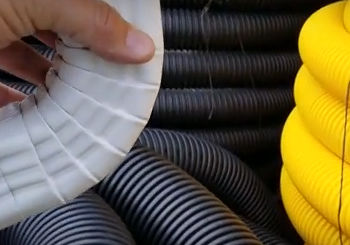 I wanted to go over the two underground downspout systems that we run an offer for, residential use. For the DIY guy, hopefully, this helps. We’re going to start out by covering the single wall. The single wall is really easy to work with. It’s very pliable. It’s just amazing actually, because in spite of all the bad reviews on how debris gets caught in the ridges and valleys, as long as it’s run on, a slope its fine. The truth is when the water comes out of the gutter troughed and it runs down the downspout, it’s accelerating. Once it hits this pipe, if you slope this pipe, you’re going to maintain that speed. You’re actually going to probably pick up some more speed. I realize there’s friction and there are all kinds of formulas for this stuff, and I’ve done it. I’m not going to get all geeky on you and we’re not going to turn it into that type of video.
I wanted to go over the two underground downspout systems that we run an offer for, residential use. For the DIY guy, hopefully, this helps. We’re going to start out by covering the single wall. The single wall is really easy to work with. It’s very pliable. It’s just amazing actually, because in spite of all the bad reviews on how debris gets caught in the ridges and valleys, as long as it’s run on, a slope its fine. The truth is when the water comes out of the gutter troughed and it runs down the downspout, it’s accelerating. Once it hits this pipe, if you slope this pipe, you’re going to maintain that speed. You’re actually going to probably pick up some more speed. I realize there’s friction and there are all kinds of formulas for this stuff, and I’ve done it. I’m not going to get all geeky on you and we’re not going to turn it into that type of video.
But do know this and just a typical ranch-style house. Say you have five PSI, you got your velocity your maintaining it, that’s going to push leaves out, that’s going to push a tree seeds out. Where they’re going to plug is right inside the gutter trough. And, if they don’t plug there, they’re definitely plugging here. Because that’s what they all look like as they bring the downspout close to the house and run it down the house. Why do I know this? Because we’re always taking these apart and pulling the leaves off for homeowners and that’s a service call nobody wants. Of course, they blame the drainage system until we get there and we prove them otherwise, and then there’s a charge for that and that’s a service call. You don’t need it. So make sure that if you have really broad leaves like a maple tree and an oak tree, you got really big trees. Make sure you get the leaf guards for your, for your gutter trough because it’s going to plug your downspouts. It’s not going to plug my system because I’m running my pipe the correct way. If this pipe is run incorrectly, it will plug just maintained slope and you’ll be fine.
Now I’m going to talk about the downspout adapter. The downspout adapter. It’s job is to get you from your downspout pipe to your corrugated pipe and it snaps right in. It works really nice. There’s a couple that I’m going to feature here today. That one was a poly drain and Normandy looks like this, I believe as well, ADS looks like that. See, it’s really clean. People like it because it actually looks like the pipe itself. It just snaps clean. That’s fine. If your house has been, um, you know, if it’s a new build, this is not a great gutter adapter for you. If it’s a house that’s been there for a few years and you had a chance for all the dirt to settle, well then this is okay. This is fine. It’s a nice clean look for sure. But I’ll show you another one. Now this one don’t have that lip.
I want to put them side by side so you can really see them. So you see the one that has like a stop. I mean it just. It’s going to stop this one. I can get it inside the corrugated pipe. A couple more clicks. Now on a new build, this is really important because there’s always a lot of settling around the house. So you want to leave this pipe up a little high and go ahead and when you’re doing your shopping, you want to pick up a downspout adapter that’s like this for new construction. It really helps. The other thing too, this pipe is real easy. It’s kind of like an accordion. You can push it up against the wall of the house, and then put dirt on it, hold it there with your foot and that’s a great idea.
A lot of my videos and now that I pointed out, everyone’s going to notice our downspouts look crooked. Our downspout pipe looks crooked to the downspout and it is because we pushed it up against the wall is as much as we can and we packed dirt on it. The reason why we do that is for that one, it settles. Come back a year later, it’s now straight, so that’s something you want to do. Most people, they get a perfectly straight. They don’t do these things that I had mentioned. What ends up happening is the following year pipe pulls away from the downspout adapter to corrugated and now you have to cut the pipe, put a larger piece of pipe in. And again this is a single wall. This is when they go to first and foremost because I just love the fact that I could run this. It doesn’t matter if it’s 20, 30, 40, 50 feet of run. It doesn’t matter. As long as I can maintain slope, I’m going to be able to flush this pipe clean of debris. On those hard rains. When there’s a lot of water coming down this downspout, it’ll blow that lid off. That NDS catch basin and all the shingle gravel and leaves that were sitting at the bottom of that catch basin, you don’t even have to clean it out. Matter of fact, the only thing you have to do is just put the lid back on. A lot of people get mad about that and I tell them it’s a lot better than having to take a shop vac and suck all the shingle gravel and leaf debris out. So I don’t know, just putting that lid back on, it doesn’t bother me any. That’s what I have at my house. I’m more happy with it. Okay.
So now if we go flat and it happens a lot over here on the southeast side of Michigan, you know, we’re, we’re kinda called flatlanders for a reason. We don’t have rolling. Rolling Hills. Got to go to the west side of the state for that or go north further north than what we are. So what we do is we go to our smooth wall pipe. No. The reason why I do this is because we’re going to lose our velocity and we’re going to end up not flushing. Having that flushing effect when the pipe is, is flatter. So I want to go to the smooth wall so it’ll just, it’s like a Teflon pan. It’s amazing. The leaves and gutter to debris. will just roll right into that catch basin. You know here I use that other downspout to corrugated pipe adapter to kind of show you how I sniffed it in further than this one because I was, I was able to. It didn’t have that shoulder on it. So that’s what I like doing on a new construction project.
Now with dual wall you have to use a single wall to get down to a 90 and you’re going to use a 90. It’s too stiff because it’s a dual wall, you know you have a smooth pipe on the interior and then you got your corrugated exterior. So it’s, it’s known as dual wall pipe. It’s very stiff and rigid. Yet when you can work with it over a longer area, it bends really nice. It’s great material to work with. I love both of these materials very much. There’s no expiration on them. The fact that there’s no glue welds and what I mean by that, all your plastic pipe, you gotta glue and every connection, and then if the grade does roll, you can’t even get your full 10 feet out of that because the resin pipes are 10 feet. So here’s the 10 footer, but if the grade isn’t perfectly flat or even if you will, even at the slope, you’ll have to cut that at four feet and then go to a 22 and so on. So you got all these glue welds. Well here in the north in the freeze and thaw, that just moves up and down and it breaks all those glue welds. It’s bad news around the trees. The trees get on them and screw them. Here we can run from the gutter adapter all the way to wherever, as long as we have slope. I love this one piece pipe. I really do. Unfortunately, with the dual wall, we do have to do a 90 degree right here and we have a PVC tape. It’s incredible. Last 100 years is. It’s really, really amazing. It’s flexible for the wintertime, so we’ll tape up and I didn’t do it because I’m going to reuse these parts. This is demonstration purposes only, but we’ll tape right here and right here. That way we don’t have any water leaking at that 90 right up against the house.
Now I like to buy these in 20 footers. Here’s a 20 footer for you. Pretty cool. So that I could run just one piece after that. If I run a really long run and I connect another 20 footer, then I’ll use that PVC tape for this pipe especially made for this pipe and it’s fantastic. It really is. The stretch to it is incredible. The way it molds itself to the pipe is fantastic, but these are the two residential systems that I highly endorse. I’ll stand behind. They don’t plug when they’re installed correctly. It’s fantastic.
The dual wall keeps people out of trouble. It really does. If you’re using a single wall, just make sure you have slope. Maintained slope. Don’t go like under a sidewalk and then come back up and leave a belly. Because now you just left an area for water to collect and debris to collect. So during the rain, when the water is accelerating down the downspout, you’re going to lose all that velocity that you built up. You’re going to lose it. When you hit that belly, you’ll be able to push water through, but you’re going to slow way down and it’s not going to move the debris. The debris will collect.
Now, I have pulled failed systems out and that’s why I know what failure with this pipe looks like. What causes it to fail, and it’s nothing that we install. It’s something that was done by well to somebody with lesser experience and I understand it. You know, this is what I do and I I better know how to do it. This is what I do. But if you’re a homeowner and you had a problem with one, now after watching this, just rerun it. This, this stuff’s easy to work with. And again, if you don’t have slope just buy some dual wall to go with it, but you’ll need the single wall for at least the initial connection and now you can see that there are options available for the adapter from the downspout to the corrugated pipe. And I’m going to keep emphasizing this. I just see it too often. We don’t need people up on ladders trying to get the leaves that have plugged their downspout right here in the gutter. Once the leaves built up and lay and get wet. It’s amazing the seal though. They’ll create and then the water just builds up in these downspouts. And think about this. You have a fascia board. It’s really thin. There’s nothing to it. It’s there more for aesthetics than anything. And in this real lightweight gutter, it can handle. But you fill this gutter trumped up with water at eight pounds per gallon, people wonder why their gutters are pulling away from the fish aboard. They wonder why they’re getting all the formed and crazy looking. Well, it’s because they plugged.
Right here is where they plug way before they get to my system. That’s where we have to take them apart when people call and say I have a problem and you got to get up on a ladder and disassemble this because to get that downspout to the wall of the house, you have to take to nineties like this to get to the straight pipe. And that’s if they don’t plug here, the going to plug here, if you’ve got the broad leaves, the real broad leaves, real big broad leaves and you’re heavily treed large trees. So make sure you get the leaf guards, there’s so many out there. So you gotta do your homework on that. It seems like everyone’s got something negative to say about each one. So it’s kind of pick your poison type thing here in the north.
You know, we do have freeze up issues too that are just, they’re just unavoidable. We’re not going to ever find a system unless you want to run heat tape through it. Now I’ve had a few clients that could do that and when I say they could do that, it’s literally something that you’ve got to be able to afford. It’s really expensive to run heat tape through this entire system, but it’s not the norm. I mean I’ve, in my career, I’ve only seen it a couple dozen times because it takes really deep pockets to do that. But if somebody’s experienced an insurance claim that the ice built up in the gutter troughs and then it got up underneath their shingles and it caused a lot of damage. That might be a case to where depending on the pitch of the roof and how the sun and even in the wintertime you get direct UV rays and it melts snow and then it turns to ice and it builds up. So depending on how the house is setting and facing and the pitch of the roof, different houses will have different problems. So sometimes you do have to go to the extremes to avoid these, these things.
Here in the north, these are the pipes you want. If your in the sunbelt region, then you guys aren’t worrying too much about this. We really have to be conscientious about creating a system that doesn’t hold water so the water doesn’t freeze up in the pipe. We have to make sure that we create a system that’s very flexible so that when the ground freezes and there are all kinds of hydraulics, you know this, this pipe is just going to be up and down and up and down. I’m exaggerating as far as trying to show you and demonstrate, but the reason why our concrete here in the north is all broken is because of the hydraulics. When there’s water in the subsoil and it freezes in the wintertime, it heaves everything. So this pipe is going to be under a lot of stress in the winter. This pipe holds up to it. This pipe is indestructible. the glue welds break, and the thin wall plastic pipe cracks. So this here, these two systems are the best systems for residential downspouts.
If I quote your home, I’m going to come out. I’m going to look at what we have for pitch, what we have on the grade and I’m going to go ahead and recommend one of or the other. Actually, I just sold the job where on one side of the House I did it in single wall and the rest of the house they had to do in a dual wall just because I didn’t have the grade that I wanted. Didn’t have a slope that I wanted and I’m and it went flat. It went flat and it was a really long run to where I had to take the water to and I knew it was going to slow down on me and I want to make sure we flush all the shingle gravel leaf debris out of the system.
For underground gutter downspout systems, give us a call at 248-505-3065. Be sure to visit the French Drain Man YouTube Channel and subscribe





